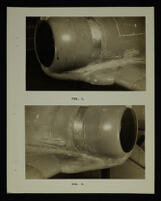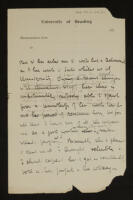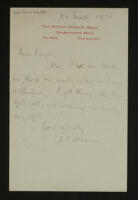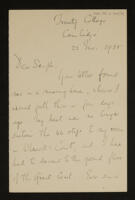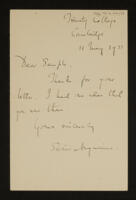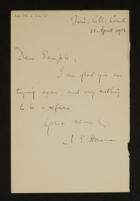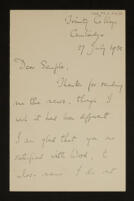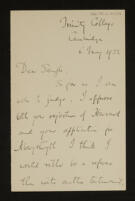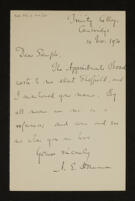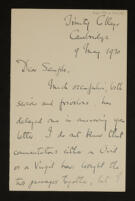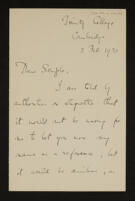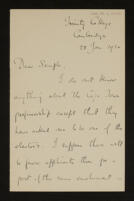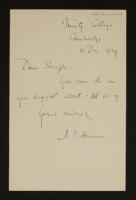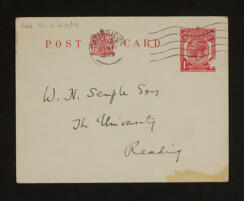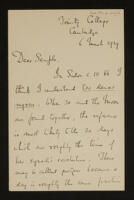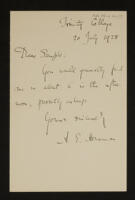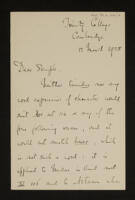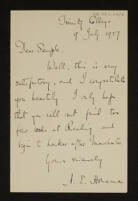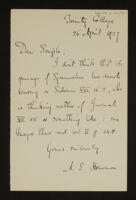The numbered papers are a.96-7, a.35-40, a.62-95 (with a blank unnumbered leaf between a.64 and a.65), a.31-2, a.41-51 (followed by a blank unnumbered leaf), a.14, a.109-14, a.98-108, d.3-8, a.131-2 (followed by two blank unnumbered leaves), d.9-69 (followed by two blank unnumbered leaves), a.115-16, a.126-7, a.119-22, a.117-18, a.124 (followed by a blank unnumbered leaf), a.130, a.128-9, a.123 (followed by a blank unnumbered leaf), a.212-25, a.233-45 (a.235 appears to have been missed out by mistake), d.70 (a printed leaf, joined to three unnumbered printed leaves), a.2-7, a.9-12, a.8, a.13 (followed by a blank unnumbered leaf), and a.15.
The headings which occur among these papers include the following:
‘Lettre. | Aux Dames’ (a.96)
‘Lettre aux Dames’ (a.35)
‘Lettres des | Deux Philantropes’ (a.62)
‘Aux Savants | Sur la Perfectibilite de LEsprit humain’ (a.41)
‘Chapitre second | sur la perfectibilité indefinie’ (unnumbered sheet)
‘dixieme époque | des progrès futurs de l’ésprit humain’ (unnumbered sheet)
‘aux Savans | Sur la perfectibilité de l’ésprit humain’ (unnumbered sheet)
‘Sur la philosophie’ (a.109)
‘Mon opinion | ou | Esquisse | d'un rapport sur l'affaire générale’ (a.98)
‘Introduction | aux | Travaux Scientifiques | du | Dix-neuvieme Siécle’ (d.3)
‘Observations générales | sur la 1re classe | des travaux Scientifiques du 18e Siécle’ (a.131)
‘introduction | aux travaux Scientifiques du | 19eme Siecle’ (unnumbered sheet)
‘introduction | aux travaux Scientifiques | du 19eme Siecle’ (d.9)
‘Premiere Partie | Livre premier | de l'univers’ (a.115)
‘Chapitre second | Considerations metaphysiques’ (a.128)
‘Chapitre troisieme | des taches du soleil’ (a.125)
‘Prospectus | d'un nouveau cours d'études Normales’ (a.212)
‘Physiques des Corps organisés | introduction’ (a.213)
‘Lettres | de | C.-H. Saint-Simon’ (printed) (d.70)


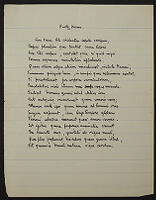
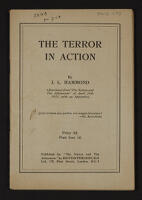
![Austin Duncan-Jones [Caius]](/uploads/r/trinity-college-library/0/1/7/0177cdc6c639762b9acb4f335f038ead62e0711a39b6cbea9b785c9f10b31673/BROD.B.2.3_thumb.jpg)
![Austin Duncan-Jones [Caius]](/uploads/r/trinity-college-library/f/6/1/f61ca32cc505a61f92819e41fe395ef138c9550d0d73851af3395ccaf20b415b/BROD.B.2.2_thumb.jpg)
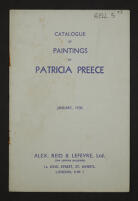
![Letter from A.J. R[obertson] to Clive Bell about The X Society](/uploads/r/trinity-college-library/f/e/3/fe3edd8f39ad8a3f3db2c61c20a96c293cf0bcfae930ec93245efac45ac0e9ec/BELL.5.14_thumb.jpg)
